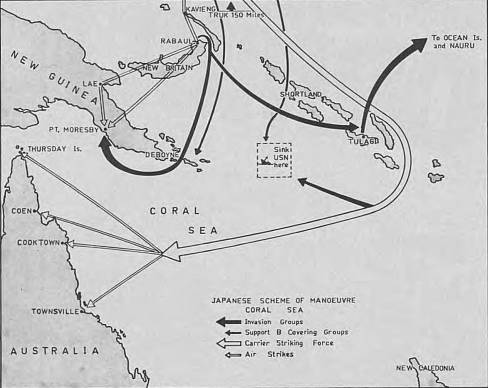- Author
- Australian-American Association
- Subjects
- WWII operations
- Tags
-
- RAN Ships
- None noted.
- Publication
- August 1972 edition of the Naval Historical Review (all rights reserved)
The Story of the Coral Sea Battle and its Significance.
In 1942 Australia’s fate was being decided by the battle of the Coral Sea, the turning-point of the Pacific war. But for American aid we should have been defeated.
THE FULL SIGNIFICANCE of the joint American-Australian Naval and Air victory in the Coral Sea Battle was not generally realised until its historical and geographical importance became evident in the march of events towards the downfall of Japan. Even today, its proximity to the Australian coastline, and the possibilities involved had the Japanese plans succeeded, are not appreciated by many.
The Coral Sea Battle was the first serious check to the amazingly rapid series of Japanese successes, which had advanced Japanese power well south of the Equator. The margin between victory and defeat was extremely small. Reliable authorities have stated that had the Japanese been successful, our position in New Guinea would have proved untenable and the whole of the north-east Australian coastline would have been open to invasion.
The Coral Sea Battle is now rightly recognised as a landmark in the history of Australia. It marks the nearest approach of hostile forces in strength to the coastline of Australia and our deliverance from threatened invasion. The significance of the Coral Sea Battle in relation to the safety of Australia is clearly seen by a glance at the map. The Australian- American Association has been fortunate to secure the attached Japanese plan of attack, which is based upon captured Japanese documents.
The accompanying plan of the concluding stage of the battle on May 8 1942 has been specially prepared by the Navy Office, and is based on official publications.
The Japanese plan and the following extracts are taken from the fully documented US Naval History of World War II, by Samuel E. Morison.
Basic Japanese War Plan

Following Japanese successes in 1941, three new conquests were planned:
- Tulagi and Port Moresby, in order to secure air mastery of the Coral Sea;
- Midway Atoll and the Western Aleutians, in order to bring the United States Pacific Fleet to a decisive engagement;
- New Caledonia, Fiji and Samoa, in order to cut lines of communication between the United States and Australasia.
All three moves were in the Japanese Basic War Plan, as stated in Japanese Combined Fleet Operation Order No. 1, promulgated Nov. 1 1941. ‘The Areas which are to be rapidly occupied or destroyed, as soon as the war situation permits’ were:
- Areas of Eastern New Guinea, New Britain, Fiji and Samoa;
- Aleutian and Midway Areas;
- Areas of the Andaman Islands;
- Important points in the Australian Area.
The whole of the ‘Op Order’ is from the Nachi Documents (recovered from cruiser Nachi in 1945), translation by Capt. E.T. Layton from the original.
Japan’s overall plan for the Coral Sea Operation was: ‘With the co-operation of the South Seas Army Detachment and the Navy, we will occupy Port Moresby and important positions on Tulagi. We will establish air bases and strengthen our air operations in the Australian area’.
The Japanese Task Force for the Coral Sea invasion comprised:
- The Port Moresby Invasion Group of eleven transports carrying both Army troops and a Naval Landing Force, screened by a destroyer squadron;
- A smaller Tulagi Invasion Group;
- A Support Group of one seaplane carrier and five other ships;
- A Covering Group consisting of light carrier Shoho, four heavy cruisers and one destroyer;
- The Striking Force of two big carriers Shokaku and Zuikaku, two heavy cruisers and six destroyers – a total of 62 ships.
The Allied Task Force, which included Australia and Hobart, consisted of two heavy carriers – Lexington and Yorktown, 8 cruisers, 13 destroyers and 3 other ships – a total of 26. It was under the command of Admiral Frank Fletcher.
Tulagi was to be occupied first, on May 3; then the Support and Covering Groups and Striking Forces would cover the Port Moresby Invasion Group, which would leave Rabaul on the 4th and land a sizeable army at Port Moresby on the 7th. (A timetable that was never carried out!).
The Japanese expected the United States Navy and the Army Air Force to try to stop them. But once the Allied Task Force entered the Coral Sea, Admiral Inouye expected to destroy it by a pincer movement, while the Invasion Group nipped through Jomard Pass into Port Moresby. Then the carriers would proceed to smash up Allied planes and ships at the four Queensland bases, as they had done so successfully at Darwin.
Admiral Chester Nimitz and General Douglas MacArthur properly regarded this Japanese thrust as a major threat. Port Moresby was not simply a place to be denied to the enemy; it was essential for General MacArthur’s strategic plans. He intended to develop this outpost as a major air base to block enemy penetration of Australia and as a starting point for his return journey to the Philippines.




